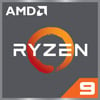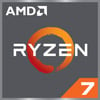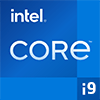
Intel Core i9-10900K vs AMD Ryzen 9 3900X
Last updated:
CPU comparison with benchmarks
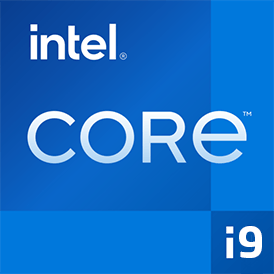
|
 |
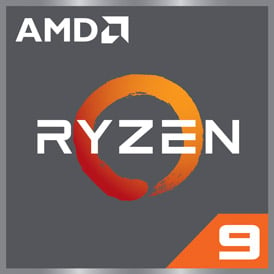
|
| Intel Core i9-10900K | AMD Ryzen 9 3900X | |
CPU comparisonIntel Core i9-10900K or AMD Ryzen 9 3900X - which processor is faster? In this comparison we look at the differences and analyze which of these two CPUs is better. We compare the technical data and benchmark results.
The Intel Core i9-10900K has 10 cores with 20 threads and clocks with a maximum frequency of 5.30 GHz. Up to 128 GB of memory is supported in 2 memory channels. The Intel Core i9-10900K was released in Q2/2020. The AMD Ryzen 9 3900X has 12 cores with 24 threads and clocks with a maximum frequency of 4.60 GHz. The CPU supports up to 128 GB of memory in 2 memory channels. The AMD Ryzen 9 3900X was released in Q3/2019. |
||
| Intel Core i9 (78) | Family | AMD Ryzen 9 (35) |
| Intel Core i 10000 (43) | CPU group | AMD Ryzen 3000 (15) |
| 10 | Generation | 3 |
| Comet Lake S | Architecture | Matisse (Zen 2) |
| Desktop / Server | Segment | Desktop / Server |
| Intel Core i9-9900K | Predecessor | -- |
| Intel Core i9-11900K | Successor | AMD Ryzen 9 5900X |
|
|
||
CPU Cores and Base FrequencyThe Intel Core i9-10900K has 10 CPU cores and can calculate 20 threads in parallel. The clock frequency of the Intel Core i9-10900K is 3.70 GHz (5.30 GHz) while the AMD Ryzen 9 3900X has 12 CPU cores and 24 threads can calculate simultaneously. The clock frequency of the AMD Ryzen 9 3900X is at 3.80 GHz (4.60 GHz). |
||
| Intel Core i9-10900K | Characteristic | AMD Ryzen 9 3900X |
| 10 | Cores | 12 |
| 20 | Threads | 24 |
| normal | Core architecture | normal |
| Yes | Hyperthreading | Yes |
| Yes | Overclocking ? | Yes |
| 3.70 GHz | Frequency | 3.80 GHz |
| 5.30 GHz | Turbo Frequency (1 Core) | 4.60 GHz |
| 4.90 GHz | Turbo Frequency (All Cores) | 4.00 GHz |
Internal GraphicsThe Intel Core i9-10900K or AMD Ryzen 9 3900X has integrated graphics, called iGPU for short. The iGPU uses the system's main memory as graphics memory and sits on the processor's die. |
||
| Intel UHD Graphics 630 | GPU | no iGPU |
| 0.35 GHz | GPU frequency | -- |
| 1.20 GHz | GPU (Turbo) | -- |
| 9.5 | GPU Generation | -- |
| 14 nm | Technology | |
| 3 | Max. displays | |
| 24 | Compute units | -- |
| 192 | Shader | -- |
| No | Hardware Raytracing | No |
| No | Frame Generation | No |
| 64 GB | Max. GPU Memory | -- |
| 12 | DirectX Version | -- |
Hardware codec supportA photo or video codec that is accelerated in hardware can greatly accelerate the working speed of a processor and extend the battery life of notebooks or smartphones when playing videos. |
||
| Intel UHD Graphics 630 | GPU | no iGPU |
| Decode / Encode | Codec h265 / HEVC (8 bit) | No |
| Decode / Encode | Codec h265 / HEVC (10 bit) | No |
| Decode / Encode | Codec h264 | No |
| Decode / Encode | Codec VP9 | No |
| Decode / Encode | Codec VP8 | No |
| No | Codec AV1 | No |
| Decode / Encode | Codec AVC | No |
| Decode | Codec VC-1 | No |
| Decode / Encode | Codec JPEG | No |
Memory & PCIeThe Intel Core i9-10900K can use up to 128 GB of memory in 2 memory channels. The maximum memory bandwidth is 46.9 GB/s. The AMD Ryzen 9 3900X supports up to 128 GB of memory in 2 memory channels and achieves a memory bandwidth of up to 51.2 GB/s. |
||
| Intel Core i9-10900K | Characteristic | AMD Ryzen 9 3900X |
| DDR4-2933 | Memory | DDR4-3200 |
| 128 GB | Max. Memory | 128 GB |
| 2 (Dual Channel) | Memory channels | 2 (Dual Channel) |
| 46.9 GB/s | Max. Bandwidth | 51.2 GB/s |
| No | ECC | Yes |
| -- | L2 Cache | 6.00 MB |
| 20.00 MB | L3 Cache | 64.00 MB |
| 3.0 | PCIe version | 4.0 |
| 16 | PCIe lanes | 20 |
| 15.8 GB/s | PCIe Bandwidth | 39.4 GB/s |
Thermal ManagementThe thermal design power (TDP for short) of the Intel Core i9-10900K is 125 W, while the AMD Ryzen 9 3900X has a TDP of 105 W. The TDP specifies the necessary cooling solution that is required to cool the processor sufficiently. |
||
| Intel Core i9-10900K | Characteristic | AMD Ryzen 9 3900X |
| 125 W | TDP (PL1 / PBP) | 105 W |
| -- | TDP (PL2) | 142 W |
| -- | TDP up | -- |
| 95 W | TDP down | -- |
| 100 °C | Tjunction max. | 95 °C |
Technical detailsThe Intel Core i9-10900K is manufactured in 14 nm and has 20.00 MB cache. The AMD Ryzen 9 3900X is manufactured in 7 nm and has a 70.00 MB cache. |
||
| Intel Core i9-10900K | Characteristic | AMD Ryzen 9 3900X |
| 14 nm | Technology | 7 nm |
| Monolithic | Chip design | Chiplet |
| x86-64 (64 bit) | Instruction set (ISA) | x86-64 (64 bit) |
| SSE4.1, SSE4.2, AVX2 | ISA extensions | SSE4a, SSE4.1, SSE4.2, AVX2, FMA3 |
| LGA 1200 | Socket | AM4 (PGA 1331) |
| VT-x, VT-x EPT, VT-d | Virtualization | AMD-V, SVM |
| Yes | AES-NI | Yes |
| Windows 10, Windows 11, Linux | Operating systems | Windows 10, Windows 11, Linux |
| Q2/2020 | Release date | Q3/2019 |
| 490 $ | Release price | 485 $ |
| show more data | show more data | |
Rate these processors
Average performance in benchmarks
⌀ Single core performance in 7 CPU benchmarks
⌀ Multi core performance in 10 CPU benchmarks
Cinebench 2024 (Single-Core)
The Cinebench 2024 benchmark is based on the Redshift rendering engine, which is also used in Maxon's 3D program Cinema 4D. The benchmark runs are each 10 minutes long to test whether the processor is limited by its heat generation.
|
|
Intel Core i9-10900K
10C 20T @ 5.30 GHz |
||
|
|
AMD Ryzen 9 3900X
12C 24T @ 4.60 GHz |
||
Cinebench 2024 (Multi-Core)
The Multi-Core test of the Cinebench 2024 benchmark uses all cpu cores to render using the Redshift rendering engine, which is also used in Maxons Cinema 4D. The benchmark run is 10 minutes long to test whether the processor is limited by its heat generation.
|
|
Intel Core i9-10900K
10C 20T @ 5.30 GHz |
||
|
|
AMD Ryzen 9 3900X
12C 24T @ 4.60 GHz |
||
Cinebench R23 (Single-Core)
Cinebench R23 is the successor of Cinebench R20 and is also based on the Cinema 4 Suite. Cinema 4 is a worldwide used software to create 3D forms. The single-core test only uses one CPU core, the amount of cores or hyperthreading ability doesn't count.
|
|
Intel Core i9-10900K
10C 20T @ 5.30 GHz |
||
|
|
AMD Ryzen 9 3900X
12C 24T @ 4.60 GHz |
||
Cinebench R23 (Multi-Core)
Cinebench R23 is the successor of Cinebench R20 and is also based on the Cinema 4 Suite. Cinema 4 is a worldwide used software to create 3D forms. The multi-core test involves all CPU cores and taks a big advantage of hyperthreading.
|
|
Intel Core i9-10900K
10C 20T @ 4.90 GHz |
||
|
|
AMD Ryzen 9 3900X
12C 24T @ 4.00 GHz |
||
Geekbench 5, 64bit (Single-Core)
Geekbench 5 is a cross plattform benchmark that heavily uses the systems memory. A fast memory will push the result a lot. The single-core test only uses one CPU core, the amount of cores or hyperthreading ability doesn't count.
|
|
Intel Core i9-10900K
10C 20T @ 5.30 GHz |
||
|
|
AMD Ryzen 9 3900X
12C 24T @ 4.60 GHz |
||
Geekbench 5, 64bit (Multi-Core)
Geekbench 5 is a cross plattform benchmark that heavily uses the systems memory. A fast memory will push the result a lot. The multi-core test involves all CPU cores and taks a big advantage of hyperthreading.
|
|
Intel Core i9-10900K
10C 20T @ 4.90 GHz |
||
|
|
AMD Ryzen 9 3900X
12C 24T @ 4.00 GHz |
||
Geekbench 6 (Single-Core)
Geekbench 6 is a benchmark for modern computers, notebooks and smartphones. What is new is an optimized utilization of newer CPU architectures, e.g. based on the big.LITTLE concept and combining CPU cores of different sizes. The single-core benchmark only evaluates the performance of the fastest CPU core, the number of CPU cores in a processor is irrelevant here.
|
|
Intel Core i9-10900K
10C 20T @ 5.30 GHz |
||
|
|
AMD Ryzen 9 3900X
12C 24T @ 4.60 GHz |
||
Geekbench 6 (Multi-Core)
Geekbench 6 is a benchmark for modern computers, notebooks and smartphones. What is new is an optimized utilization of newer CPU architectures, e.g. based on the big.LITTLE concept and combining CPU cores of different sizes. The multi-core benchmark evaluates the performance of all of the processor's CPU cores. Virtual thread improvements such as AMD SMT or Intel's Hyper-Threading have a positive impact on the benchmark result.
|
|
Intel Core i9-10900K
10C 20T @ 4.90 GHz |
||
|
|
AMD Ryzen 9 3900X
12C 24T @ 4.00 GHz |
||
Cinebench R20 (Single-Core)
Cinebench R20 is the successor of Cinebench R15 and is also based on the Cinema 4 Suite. Cinema 4 is a worldwide used software to create 3D forms. The single-core test only uses one CPU core, the amount of cores or hyperthreading ability doesn't count.
|
|
Intel Core i9-10900K
10C 20T @ 5.30 GHz |
||
|
|
AMD Ryzen 9 3900X
12C 24T @ 4.60 GHz |
||
Cinebench R20 (Multi-Core)
Cinebench R20 is the successor of Cinebench R15 and is also based on the Cinema 4 Suite. Cinema 4 is a worldwide used software to create 3D forms. The multi-core test involves all CPU cores and taks a big advantage of hyperthreading.
|
|
Intel Core i9-10900K
10C 20T @ 4.90 GHz |
||
|
|
AMD Ryzen 9 3900X
12C 24T @ 4.00 GHz |
||
Blender 3.1 Benchmark
In the Blender Benchmark 3.1, the scenes "monster", "junkshop" and "classroom" are rendered and the time required by the system is measured. In our benchmark we test the CPU and not the graphics card. Blender 3.1 was presented as a standalone version in March 2022.
|
|
Intel Core i9-10900K
10C 20T @ 4.90 GHz |
||
|
|
AMD Ryzen 9 3900X
12C 24T @ 4.00 GHz |
||
Estimated results for PassMark CPU Mark
Some of the CPUs listed below have been benchmarked by CPU-monkey. However the majority of CPUs have not been tested and the results have been estimated by a CPU-monkey’s secret proprietary formula. As such they do not accurately reflect the actual Passmark CPU mark values and are not endorsed by PassMark Software Pty Ltd.
|
|
Intel Core i9-10900K
10C 20T @ 4.90 GHz |
||
|
|
AMD Ryzen 9 3900X
12C 24T @ 4.00 GHz |
||
Blender 2.81 (bmw27)
Blender is a free 3D graphics software for rendering (creating) 3D bodies, which can also be textured and animated in the software. The Blender benchmark creates predefined scenes and measures the time (s) required for the entire scene. The shorter the time required, the better. We selected bmw27 as the benchmark scene.
|
|
Intel Core i9-10900K
10C 20T @ 4.90 GHz |
||
|
|
AMD Ryzen 9 3900X
12C 24T @ 4.00 GHz |
||
CPU-Z Benchmark 17 (Single-Core)
The CPU-Z benchmark measures a processor's performance by measuring the time it takes the system to complete all benchmark calculations. The faster the benchmark is completed, the higher the score.
|
|
Intel Core i9-10900K
10C 20T @ 4.90 GHz |
||
|
|
AMD Ryzen 9 3900X
12C 24T @ 4.00 GHz |
||
CPU-Z Benchmark 17 (Multi-Core)
The CPU-Z benchmark measures a processor's performance by measuring the time it takes the system to complete all benchmark calculations. The faster the benchmark is completed, the higher the score.
|
|
Intel Core i9-10900K
10C 20T @ 3.70 GHz |
||
|
|
AMD Ryzen 9 3900X
12C 24T @ 3.80 GHz |
||
Cinebench R15 (Single-Core)
Cinebench R15 is the successor of Cinebench 11.5 and is also based on the Cinema 4 Suite. Cinema 4 is a worldwide used software to create 3D forms. The single-core test only uses one CPU core, the amount of cores or hyperthreading ability doesn't count.
|
|
Intel Core i9-10900K
10C 20T @ 5.30 GHz |
||
|
|
AMD Ryzen 9 3900X
12C 24T @ 4.60 GHz |
||
Cinebench R15 (Multi-Core)
Cinebench R15 is the successor of Cinebench 11.5 and is also based on the Cinema 4 Suite. Cinema 4 is a worldwide used software to create 3D forms. The multi-core test involves all CPU cores and taks a big advantage of hyperthreading.
|
|
Intel Core i9-10900K
10C 20T @ 4.90 GHz |
||
|
|
AMD Ryzen 9 3900X
12C 24T @ 4.00 GHz |
||
iGPU - FP32 Performance (Single-precision GFLOPS)
The theoretical computing performance of the internal graphics unit of the processor with simple accuracy (32 bit) in GFLOPS. GFLOPS indicates how many billion floating point operations the iGPU can perform per second.
|
|
Intel Core i9-10900K
Intel UHD Graphics 630 @ 1.20 GHz |
||
|
|
AMD Ryzen 9 3900X
@ 0.00 GHz |
||
Devices using this processor |
|
| Intel Core i9-10900K | AMD Ryzen 9 3900X |
| Unknown | Unknown |
Comparison of the two processors
With the AMD Ryzen 9 3900X, AMD positions a 12 core processor against Intel's mainstream top model, the Intel Core i9-10900K. The latter has 10 cores (20 threads) that can be clocked at up to 4.9 GHz. The maximum turbo is even 5.3 GHz in single-core mode. This sets a record for the clock frequency of desktop processors based on x86-64.The AMD Ryzen 9 3900X cannot clock its 12 cores (24 threads) quite as high with 4.2 GHz (multi-core) or 4.6 GHz (single-core). However, the 12-core processor based on the Zen-2 architecture has a higher computing power per clock (IPC), so that it achieves a performance similar to the Intel Core i9-10900K under single-core load. For applications that are very much adapted to multi-threading, the AMD processor is approx. 10 percent faster than the Intel Core i9-10900K.
Both processors have an open multiplier and are officially approved for overclocking. However, both processors are clocked quite high ex works, so that hardly any further clock increases are possible with the Intel Core i9-10900K. In addition, the waste heat of the CPUs increases sharply during overclocking. Since Intel's 10-core processor already exceeds 225 watts under full load, very good air or, better, water cooling is required here to get the additional waste heat under control.
Both processors support up to 128 GB of RAM in two memory channels. Intel's processor is officially approved up to DDR4-2933, the AMD Ryzen 9 3900X even up to DDR4-3200. The clock frequency of the main memory can also be increased above the official values. This can be done manually or via D.O.C.P. (AMD) or XMP (Intel) profile and requires a correspondingly approved memory. When it comes to the maximum clock frequencies of the memory, Intel is currently ahead of the game, because most processors manage DDR-4000, while AMD usually ends with DDR4-3600 / DDR4-3800 as long as the BLCK is not increased.
Popular comparisons containing this CPUs
back to index




